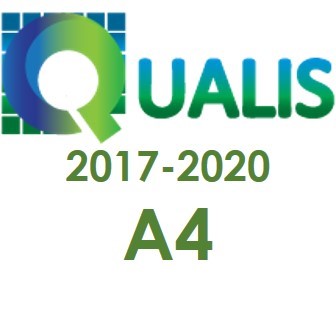Produção e caracterização de vidros aluminato de cálcio dopados com os terras-raras Dy3+ e Sm3+ e co-dopado com Dy3+/Sm3+ para a geração de luz branca
Palavras-chave:
Luminescência. Vidros. Terras-raras. Geração de luz branca.Resumo
Este trabalho consiste na produção e caracterização de vidros aluminato de cálcio dopados com Dy3+/Sm3+, com a proposta de aplicação na geração de luz branca. Os vidros foram produzidos pela técnica de fusão/resfriamento e apresentaram aumento na densidade com a inserção dos dopantes. Os espectros de absorção e de luminescência evidenciaram as transições características dos terras-raras. Para as amostras co-dopadas, sob excitação em 360 nm, a inserção de 0,5%mol do samário deslocou a CCT de 4002 K para 3433 K, região de luz branca mais quente. Nessa perspectiva, o trabalho demonstra a possibilidade do controle da coloração da luz emitida.
Downloads
Referências
ARGUELLO, Z. P.; BILAC, S. A.; TOMYIAMA, M. On the color variation of a calcium aluminate glass. Glass Technology, v. 22, n. 4, p. 186–189, 1981.
BISWAS, J.; JANA, S. Comparative studies on CIELab, thermal and optical characteristics of Dysprosium (Dy3+) incorporated phospho-tellurite glasses for white light generation. Optical Materials, v. 141, p. 113932, 1 jul. 2023.
BORRERO-GONZÁLEZ, L. J. et al. Near-infrared quantum cutting in OH- free Nd3+- Yb3+ co-doped low-silica calcium aluminosilicate glasses. Journal of Applied Physics, v. 114, n. 1, 7 jul. 2013.
CAO, J. et al. Structure and fluorescence characteristics in highly Dy3+ doped tellurite-fluoride glass for white light fiber lasers. Ceramics International, v. 49, n. 11, p. 16536–16544, 1 jun. 2023.
CARNEIRO, G. N. Síntese e caracterização de vidros aluminoborato de bário dopados com Dy2O3 , Tm2O3 e Eu2O3 para aplicações como fonte de luz branca artificial. Tese de Doutorado—[s.l.] Universidade Estadual do Norte Fluminense Darcy Ribeiro, 2018.
DAMODARAIAH, S.; RATNAKARAM, Y. C. Energy transfer studies and neutral to warm white light generation in Dy3+-Sm3+ co-doped bismuth phosphate glasses for lighting applications. Journal of Luminescence, v. 207, p. 553–560, 1 mar. 2019.
DAVY, J. R. Development of calcium aluminate glasses for use in the infrared spectrum to 5 um. Glass Technology, v. 19, n. 2, p. 32–36, 1978.
DEJNEKA, M. J. et al. Rare earth-doped glass microbarcodes. Proceedings of the National Academy of Sciences, v. 100, n. 2, p. 389–393, 2003.
DENKER, B. I.; GALAGAN, B. I.; SVERCHKOV, S. E. Laser potential of calcium aluminate glasses. Journal of Non-Crystalline Solids, v. 496, p. 29–33, 15 set. 2018.
HOSSAIN, M. K. et al. A Review on Optical Applications, Prospects, and Challenges of Rare-Earth Oxides. ACS Applied Electronic Materials, v. 3, n. 9, p. 3715–3746, 28 set. 2021.
JOU, J. H. et al. Sunlight-style color-temperature tunable organic light-emitting diode. Applied Physics Letters, v. 95, n. 1, 2009.
KHAN, I. et al. Photoluminescence and white light generation of Dy2O3 doped Li2O-BaO-Gd2O3- SiO2 for white light LED. Journal of Alloys and Compounds, v. 774, p. 244–254, 5 fev. 2019.
LODI, T. A. Síntese e caracterização de vidros cálcio boroaluminato dopados com Dy2O3 para a geração de luz branca. Dissertação de mestrado—Imperatriz: Universidade Federal do Maranhão, 2018.
MCCAMY, C. S. Correlated Color Temperature as an Explicit Function of Chromaticity Coordinates. Color Research & Application, p. 142–144, 1992.
NARDELLI, A. et al. Assessment of Light Emitting Diodes technology for general lighting: A critical review. Renewable and Sustainable Energy Reviews, v. 75, p. 368–379, 2017.
PENA, C. F. Síntese e caracterização de vidros aluminato de cálcio dopados com itérbio e cromo. Tese de doutorado—[s.l.] Universidade Estadual do Norte Fluminense Darcy Ribeiro, 2019.
PENG, Y. et al. Heat Dissipation Enhancement of Phosphor-Converted White Laser Diodes by Thermally Self-Managing Phosphor-in-Glass. IEEE Transactions on Electron Devices, v. 67, n. 10, p. 4288–4292, 1 out. 2020.
QIAO, J. et al. Recent advances in solid-state LED phosphors with thermally stable luminescence. Journal of Rare Earths, v. 37, n. 6, p. 565–572, 1 jun. 2019.
RAMARAGHAVULU, R. et al. Excitation-dependent energy transfer and color tunability in Dy3+/Eu3+ co-doped multi-component borophosphate glasses. Journal of the American Ceramic Society, v. 106, n. 6, p. 3509–3524, 1 jun. 2023.
RAVITA et al. Photoluminescence and energy transfer studies on Tm3+/Dy3+/Eu3+doped borosilicate glasses for color tunability and warm white light generation. Journal of Non-Crystalline Solids, v. 606, p. 122192, 15 abr. 2023.
RIBEIRO, A. C. C. et al. O emprego da tecnologia LED na iluminação pública. e-xacta, v. 5, n. 1, p. 111–132, 2012.
SCHUBERT, E. F.; KIM, J. K. Solid-State Light Sources Getting Smart. Science, v. 308, 2005.
SHELBY, J. E. Introduction to Glass Science and Technology. 2a edição ed. [s.l: s.n.].
TAN, S. T. et al. Advances in the LED materials and architectures for energy-saving solid-state lighting toward lighting revolution. IEEE Photonics Journal, v. 4, n. 2, p. 613–619, 2012.
VIJAYALAKSHMI, L.; KUMAR, K. N.; BAEK, J. D. Multicolor and warm white luminescence from Dy3+/Eu3+ co-activated glasses for indoor and solid-state lighting applications. Ceramics International, v. 49, n. 3, p. 5013–5021, 1 fev. 2023.
VOGEL, W. Survey of the Physical Basis of Some Glass Properties. Em: Glass Chemistry. Berlin: Springer-Verlarg, 1994. p. 408–425.
YAMASHITA, M. et al. Effect of preparation procedure on redox states of iron in soda-lime silicate glass. Journal of Non-Crystalline Solids, v. 354, p. 4534–4538, 2008.
YE, S. et al. Phosphors in phosphor-converted white light-emitting diodes: Recent advances in materials, techniques and properties. Materials Science and Engineering R: Reports, v. 71, n. 1, p. 1–34, 1 dez. 2010.
Arquivos adicionais
Publicado
Como Citar
Edição
Seção
Licença
Copyright (c) 2023 Revista Brasileira de Iniciação Científica

Este trabalho está licenciado sob uma licença Creative Commons Attribution-NonCommercial-ShareAlike 4.0 International License.




